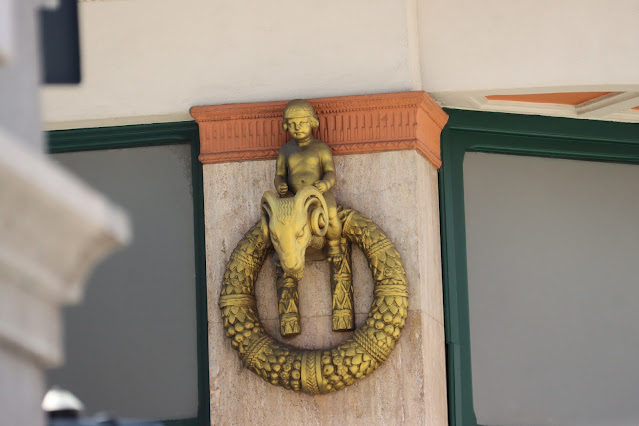We had a little sleep in this morning and then decided to head down into Rijeka. Cameron had some university work to do, so he stayed behind to get that done (or to play games on his laptop...) while Kristine, Tomas and I headed down into Rijeka.
The first thing I noticed was how mountainous the area was. I had researched buildings and things to see in Rijeka, but not really looked at the area. Originally I had thought we could walk into town from our accommodation, but that would have been crazy (especially in the heat) as the roads were very steep. Driving wasn't a lot better due to narrow roads, sharp turns and cars parked in every available space. Rijeka was commonly visited by cruise ship, which definitely would have been an easier way to visit. We eventually found a park in a very tiny carpark that our huge car could only just navigate.
Rijeka has had many owners through history - being a deep water port in a calm bay in the Adriatic sea it has been prime territory. The original name for the town was Tharsatica, Vitopolis (City of St Vitus) or Flumen (River). The name Rijeka means river in Croatian.
The area has been settled since Neolithic (~10,000BC) and the first known settlers were the Celts who founded Tharsatica in Trasat on the hill above Rijeka. The town was renamed after St Vitus, the town's patron saint in the 4th century.
It has been ruled by the Ostrogoths, Byzantines, Lombards and the Avars. Attila the Hun burnt the city down in 452 and it was settled by the Croat people in the 600s. The city was built into a stronghold with a wall and fortress to protect it.
In 799 Charlemange and the Frankish troops attacked the city and laid siege. They destroyed the castle, and put the area under the Carolingian Empire. In 925 the town became part of the Kingdom of Croatia and part of the Kingdom of Hungary in 1102. Between 1300-1466 Rijeka was ruled by novel families and grew to rival Venice for a period of time before being sold to the Habsburgs. The Venetians raided the town several times and nearly destroyed the town in 1508 and 1509. The Ottomans also attacked multiple times in this period but never managed to take the town. Having been rebuild after the battles, Rijeka was again destroyed, this time by a massive earthquake in 1750. At this point it was rebuilt to be a modern city rather than a walled fortress.
The city then passed into Hungarian hands as part of the Empire of Hungary, was captured by the French in 1809 and recaptured by Austria in 1813.
But our visit to Rijeka started down some narrow roads and into a rather cramped and unimpressive carpark:
 |
| Narrow roads with Trsat Castle in the background |
Towering over Rijeka is the Trsat Castle (Gradina Trsat) we initially tried to drive to the castle but the roads were narrow and packed with parked cars so we gave up. The easiest way to get to the castle was via steps from town, but we settled on taking pictures from the nearby areas.
The castle was placed at the site of an Illyria and Roman fortress. The current castle was built in the 1200s to trade down the Rječina River to the sea and to protect the town and docks:
Having parked the car, we walked into the main part of town and to our first stop, the City Tower. Originally guarding the entry to the fortified town, the tower was build in the Middle Ages and houses the town clock as well as the Rijeka double-headed eagle heraldry (which is unusual in that both eagles heads face the same direction). The eagle holds an urn with an unlimited supply of water, representing the infinite loyalty of the city to the Austrian Empire. The motto "INDEFICIENTER" meaning inexhaustible or unfailing is also carved into the tower.
After WWI one of the heads of the eagles was removed to make it more like the Roman eagle instead of the German one and after WWII the eagle was removed completely.:

We then headed back to the gate tower, passing through towards one of the sites I was most excited to see - the Rijeka Roman Arch. The arch is a remnant from the Roman times, built as an entrance into the praetorium - the army command rooms. It is the oldest architecture monument in Rijeka. Unfortunately, as per a lot of this trip, it was under renovations:
Through the arch was the remains of the Tarsatica Roman Settlement, including a scope that showed the site as it might have been:
We then headed to the Cathedral of St Vitus (Katedrala Svetog Vida):
The current cathedral was built in 1638 by Jesuits in Rijeka. Behind the cathedral was the entrance to the Rijeka tunnel. Similar to the Grič Tunnel, this was a pedestrian tunnel that was built in 1939 as a bomb shelter from allied bombing. The tunnel was closed in 1942 and reopened to the public in 2017 as a tourist attraction and a nice break from the heat:
 |
| Reserved for Anti-Aircraft Corps |
After leaving the tunnel we headed out to grab some lunch and extract the car from the carpark. We stopped on the way back to our apartment to take some pictures over the harbour:























































No comments:
Post a Comment